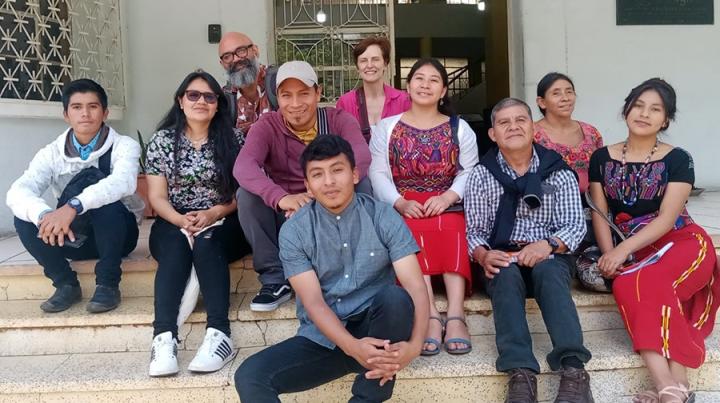Komon Sajb'ichil for Ixil cartographies during the Cold War: Knowledge exchange for intergenerational justice (February 2023-August 2025)
Dr Julie Gibbings is the Principal Investigator on this research project, with co-investigator Feliciana Herrera Sitp’op, Postdoctoral Fellow Alejandro Flores, and project partners Ixil University and the Ancestral Authorities of the Ixil Region.

This is an interdisciplinary and collaborative research project modelled on the lxil practice of Komon Sajb'ichil (New Dawn through Community). The Komon Sajb'ichil is a communal ritual that begins every spring, when it is time to plant a new field of maize. Upon the request of an Ixil family, the entire community works in rotation through the night to complete ancestral ceremonies until the sajb'ichal (new dawn), when the whole community awakens to plant corn. This is a communal labour rooted in Maya principles of solidarity and reciprocity to cultivate a new beginning and ensure prosperity for all. Grounded in the theory and method of Komon Sajb'ichil, our collaborative research project seeks to remember Ixil cartographies—the ways they navigated, understood, and represented places--in the midst of insurrection, state terror, exile, and refuge, to prepare for a new future.
The Ixil region, located in the Department of El Quiche, was the epicentre of genocide during the Guatemalan civil war (1960-1996). Ixil Mayas, who comprise the majority of the population, formed one of the crucial bases of support for armed revolutionaries. In response, the Guatemalan military unleashed unthinkable violence, which according to the Historical Clarification Commission included at least 114 state-sponsored massacres in that region alone. As Jennifer Schirmer has argued, the army systematically "destroyed, reconstructed and penetrated the geographic and cultural fabric of villages." The military redrew municipal boundaries, usurped communal territories, planed for hydro-electric dams and mines, scorched the earth, and rearranged villages into 'models' that could be governed by the military. At the same time, Ixiles participated in the war as guerrillas, as populations in resistance, as soldiers, and as civil patrol, using their knowledge of their local territories. Among those displaced by the war, Mayas recalled that "the sacred forest saved us" as they sought refuge from state terror. The geographical meaning of the war carried significant consequences for Ixiles, since being forced off the land, where their ancestors remain, entailed a shameful separation from their spiritual origins. This separation of the physical from the spiritual dimensions of family life compounded the psychological and physical trauma of war. By seeking to recover Ixil histories and memories of the places where the war was waged, this project recognises intergenerational knowledge and sharing as the keys to communal healing and justice. This research is also timely: all three of the municipalities that compose the Ixil region are beginning legal processes to recover territories lost during the civil war.
Cartography has played a crucial role in the colonisation and dispossession of Indigenous territory, including during the Latin American Cold War. As a result, Indigenous and Afro-Latin communities have been undertaking participatory countermapping projects across Latin America since the 1970s. These have used participatory mapping technologies such as GIS to strengthen self-determination within their own territories and to document and represent their own conceptions of time, place, and space. Inspired by participatory counter-mapping yet in stark contrast to abstract spaces of the map, our research seeks to co-create an inter-active visual and oral archive of memorialized and experienced places. This will include visual ethnographies, oral histories, and hand-drawn maps based on Ixil memories, state-produced maps of model villages, geological ,and fluvial resources. In addition, we will publish high-impact articles, book chapters, and editorials that will reflect upon our collaborative methodology and reveal how Indigenous geographic epistemologies shaped one of the central legacies of the Latin American Cold War.

